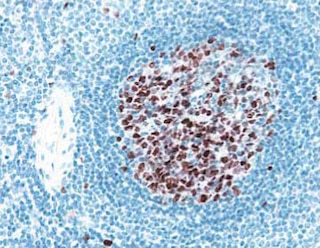-
Your selected country is
Middle East / Africa
- Change country/language
Old Browser
This page has been recently translated and is available in French now.
Looks like you're visiting us from {countryName}.
Would you like to stay on the current country site or be switched to your country?






LEFT: Western blot analysis of somatostatin expression. Lysate from human somatostatin-transfected 293F cells was prepared for electrophoresis (SDS-PAGE) in a 2D Tris-Glycine polyacrylamide gel. The proteins were transferred to PVDF membranes and then probed with 1.25 (lane 1), 0.6 (lane 2), and 0.3 (lane 3) ng/mL of Purified Mouse Anti-Human Somatostatin (Cat. No. 566031). Specific staining was detected with HRP Goat Anti-Mouse Ig (Cat No 554002). The detected protein has the predicted molecular weight of preprosomatostatin. RIGHT: Flow cytometric analysis of somatostatin expression in human somatostatin-transfected 293F cells. Untransfected (dashed-line histogram) and human somatostatin-transfected (solid-line histogram) 293F cells were fixed with BD Cytofix™ Fixation Buffer (Cat. No. 554655) and permeabilized with BD Phosflow™ Perm Buffer III (Cat. No. 558050). The cells were washed and then stained with Purified Mouse Anti-Human Somatostatin (Cat. No. 566031) followed by PE Goat Anti-Mouse Ig (Cat. No. 550589). The fluorescence histograms were derived from gated events with the forward and side light-scatter characteristics of intact cells. Flow cytometry was performed on a BD FACSCanto™ II flow cytometry system.

Immunohistochemical staining of somatostatin in human islets of Langerhans. Following antigen retrieval with BD Retrievagen A Buffer (Cat. No. 550524), sections from formalin-fixed, paraffin-embedded human pancreas were blocked using an Avidin/Biotin Blocking Kit (Vector Laboratories, Cat. No. SP-2001) as recommended by the manufacturer. The sections were then stained overnight with either Purified Mouse IgG2b, κ Isotype Control (Cat. No. 557351, left panel) or Purified Mouse Anti-Human Somatostatin (Cat. No. 566031, right panel). A three-step staining procedure that employs Biotin Goat Anti-Mouse Ig (Cat. No. 550337) Streptavidin HRP (Cat. No. 550946) and DAB (Cat. No. 550880) was used to reveal the primary staining reagents. Counterstaining was with Hematoxylin. Original magnification: 40×.


BD Pharmingen™ Purified Mouse Anti-Human Somatostatin

BD Pharmingen™ Purified Mouse Anti-Human Somatostatin

Regulatory Status Legend
Any use of products other than the permitted use without the express written authorization of Becton, Dickinson and Company is strictly prohibited.
Preparation And Storage
Product Notices
- Since applications vary, each investigator should titrate the reagent to obtain optimal results.
- Please refer to www.bdbiosciences.com/us/s/resources for technical protocols.
- Caution: Sodium azide yields highly toxic hydrazoic acid under acidic conditions. Dilute azide compounds in running water before discarding to avoid accumulation of potentially explosive deposits in plumbing.
- Sodium azide is a reversible inhibitor of oxidative metabolism; therefore, antibody preparations containing this preservative agent must not be used in cell cultures nor injected into animals. Sodium azide may be removed by washing stained cells or plate-bound antibody or dialyzing soluble antibody in sodium azide-free buffer. Since endotoxin may also affect the results of functional studies, we recommend the NA/LE (No Azide/Low Endotoxin) antibody format, if available, for in vitro and in vivo use.
- An isotype control should be used at the same concentration as the antibody of interest.
Companion Products






Somatostatin is produced by neuroendocrine neurons in the hypothalamus and δ cells in the islets of Langerhans of the pancreas. It is a regulatory hormone that affects neurotransmission, cell proliferation, and numerous hormones of the endocrine system. Via interaction with high affinity G protein-coupled somatostatin receptors, it inhibits the secretion of somatotropin (also known as growth hormone or GH), thyroid-stimulating hormone (thyrotropin or TSH), and most gastrointestinal and pancreatic hormones, including glucagon and insulin. The expression of somatostatin can be used to monitor the pancreatic differentiation of pluripotent stem cells.
The human somatostatin gene, SST, encodes the precursor molecule preprosomatostatin (amino acids 1-116), which is cleaved to form prosomatostatin (amino acids 15-116), which in turn is cleaved to form either of 2 alternative active somatostatin peptides, somatostatin-28 (amino acids 89-116) or somatostatin-14 (amino acids 103-116). The U16-850 monoclonal antibody detects human preprosomatostatin in somatostatin-producing cells.
Development References (4)
-
D'Amour KA, Bang AG, Eliazer S, et al . Production of pancreatic hormone-expressing endocrine cells from human embryonic stem cells. Nat Biotechnol. 2006; 24(12):1481-1483. (Biology). View Reference
-
Goodman RH, Montminy MR, Low MJ, Habener JF. Biosynthesis of rat preprosomatostatin.. Adv Exp Med Biol. 1985; 188:31-47. (Biology). View Reference
-
Kelly OG, Chan MY, Martinson LA, et al. Cell-surface markers for the isolation of pancreatic cell types derived from human embryonic stem cells. Nat Biotechnol. 2011; 29(8):750-756. (Biology). View Reference
-
Montminy MR, Goodman RH, Horovitch SJ, Habener JF. Primary structure of the gene encoding rat preprosomatostatin.. Proc Natl Acad Sci USA. 1984; 81(11):3337-40. (Biology). View Reference
Please refer to Support Documents for Quality Certificates
Global - Refer to manufacturer's instructions for use and related User Manuals and Technical data sheets before using this products as described
Comparisons, where applicable, are made against older BD Technology, manual methods or are general performance claims. Comparisons are not made against non-BD technologies, unless otherwise noted.
For Research Use Only. Not for use in diagnostic or therapeutic procedures.
Report a Site Issue
This form is intended to help us improve our website experience. For other support, please visit our Contact Us page.